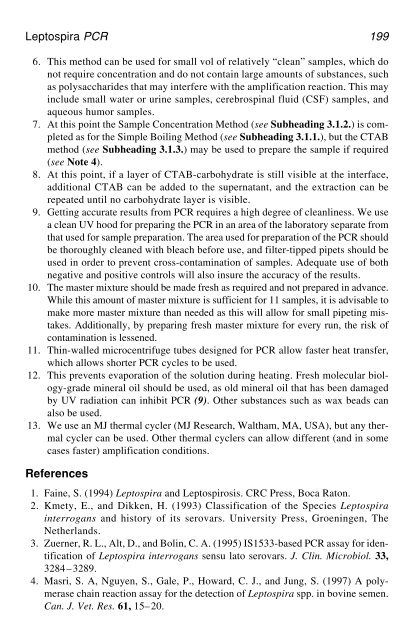PCR Detection of Microbial Pathogens PCR Detection of Microbial ...
PCR Detection of Microbial Pathogens PCR Detection of Microbial ...
PCR Detection of Microbial Pathogens PCR Detection of Microbial ...
You also want an ePaper? Increase the reach of your titles
YUMPU automatically turns print PDFs into web optimized ePapers that Google loves.
Leptospira <strong>PCR</strong> 199<br />
6. This method can be used for small vol <strong>of</strong> relatively “clean” samples, which do<br />
not require concentration and do not contain large amounts <strong>of</strong> substances, such<br />
as polysaccharides that may interfere with the amplification reaction. This may<br />
include small water or urine samples, cerebrospinal fluid (CSF) samples, and<br />
aqueous humor samples.<br />
7. At this point the Sample Concentration Method (see Subheading 3.1.2.) is completed<br />
as for the Simple Boiling Method (see Subheading 3.1.1.), but the CTAB<br />
method (see Subheading 3.1.3.) may be used to prepare the sample if required<br />
(see Note 4).<br />
8. At this point, if a layer <strong>of</strong> CTAB-carbohydrate is still visible at the interface,<br />
additional CTAB can be added to the supernatant, and the extraction can be<br />
repeated until no carbohydrate layer is visible.<br />
9. Getting accurate results from <strong>PCR</strong> requires a high degree <strong>of</strong> cleanliness. We use<br />
a clean UV hood for preparing the <strong>PCR</strong> in an area <strong>of</strong> the laboratory separate from<br />
that used for sample preparation. The area used for preparation <strong>of</strong> the <strong>PCR</strong> should<br />
be thoroughly cleaned with bleach before use, and filter-tipped pipets should be<br />
used in order to prevent cross-contamination <strong>of</strong> samples. Adequate use <strong>of</strong> both<br />
negative and positive controls will also insure the accuracy <strong>of</strong> the results.<br />
10. The master mixture should be made fresh as required and not prepared in advance.<br />
While this amount <strong>of</strong> master mixture is sufficient for 11 samples, it is advisable to<br />
make more master mixture than needed as this will allow for small pipeting mistakes.<br />
Additionally, by preparing fresh master mixture for every run, the risk <strong>of</strong><br />
contamination is lessened.<br />
11. Thin-walled microcentrifuge tubes designed for <strong>PCR</strong> allow faster heat transfer,<br />
which allows shorter <strong>PCR</strong> cycles to be used.<br />
12. This prevents evaporation <strong>of</strong> the solution during heating. Fresh molecular biology-grade<br />
mineral oil should be used, as old mineral oil that has been damaged<br />
by UV radiation can inhibit <strong>PCR</strong> (9). Other substances such as wax beads can<br />
also be used.<br />
13. We use an MJ thermal cycler (MJ Research, Waltham, MA, USA), but any thermal<br />
cycler can be used. Other thermal cyclers can allow different (and in some<br />
cases faster) amplification conditions.<br />
References<br />
1. Faine, S. (1994) Leptospira and Leptospirosis. CRC Press, Boca Raton.<br />
2. Kmety, E., and Dikken, H. (1993) Classification <strong>of</strong> the Species Leptospira<br />
interrogans and history <strong>of</strong> its serovars. University Press, Groeningen, The<br />
Netherlands.<br />
3. Zuerner, R. L., Alt, D., and Bolin, C. A. (1995) IS1533-based <strong>PCR</strong> assay for identification<br />
<strong>of</strong> Leptospira interrogans sensu lato serovars. J. Clin. Microbiol. 33,<br />
3284–3289.<br />
4. Masri, S. A, Nguyen, S., Gale, P., Howard, C. J., and Jung, S. (1997) A polymerase<br />
chain reaction assay for the detection <strong>of</strong> Leptospira spp. in bovine semen.<br />
Can. J. Vet. Res. 61, 15–20.






